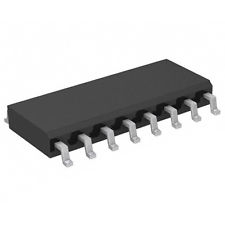Turbocharging the decode chip
Introduction
The Z88 Flash/RAM card has been working for several years now. When OZ 4.6 was introduced, allowing applications to be run in RAM, some games failed to run.
| Standard Version | Modified Turbo Version |
|---|---|
This was found to be due to an intermittent timing error from the decode chip CD74HCT139 which switches between the RAM and Flash chip.
Although this is one of the fastest decode chips, taking 10nS, the software speed improvements pushed it outside these limits.
This documents the steps taken to rectify this. The detail of the steps taken are in subsections, allowing the reader to go into detail if required.
Object
The object of this exercise is to see if by redefining the design on a small PCB, with the same footprint (SMD SO16) of the existing decode chip, a faster decode could be achieved by
- Using high speed NAND gates, to see if then if that was successful
- Use a decode chip from the same family.
- Using the knowledge gained, add more components to make a high speed 74xx139 card.
NAND Gate Build
Building the circuit on a breadboard externally
5 NAND gates were used to test whether a faster time could be achieved with the Z88.
Results
The latest software was tried again in a standard 512K/512K Flash/RAM Card and Vic could not make the games software go wrong. The prototype board was packed and sent to Mr T who had a failing Z88 and 512K/512K Flash/RAM Card. He confirmed that it was the decoder chip that was causing the fault and suggested that another decoder could be found.
DECODER Chip Build
Building the circuit on a breadboard externally
Using 5 NAND Gates to prove that there is a hardware problem was very useful, but for a production run using a single 2-to-4 Line Decoder chip to replace them is the next step.
This circuit could now be bread-boarded and tested outside the Z88 card case again.
The four signal and power lines can be seen connecting the card to the breadboard.
Results
The Games played without crashing. The PCB could now be designed.
Z88 Turbo Card produced
It has been proved that the decode chip in the Z88 Flash/RAM card is too slow. Existing users who wish to run applications in RAM will need their cards modified with the chip being replaced with this card.
Full 74xx139 Version Build Concept
A new opportunity or a waste of time?
The decoder chip above works. It changes the timing from 10 to 3nS and replaces 1/4 of the 74139 in the Z88 design. Is there a demand for a full 74xx139 replacement card?
For the full version, adding 2 OR, dual logic gates to the outputs adds the /CE signal to the design. The challenge is to
- fit 6 chips into a 16 pin DIL footprint
- establish whether there is a demand
SMD or DIL Footprint?
| 16 pin DIL | 16 pin SO 16 |
|---|---|
Using the Z88 Turbo Card fitting pins or wires to connect the 74xx139 Card piggybacked both footprints may be accommodated. This has proved to be impractical. Another design needs to be considered if required perhaps using a slot across the middle to connect the SO16 footprint to the card.
Build 74xx139 on a 16 pin DIL footprint
This should be possible, 3 chips on each side of the PCB with 2 rows of 8 pins on either side.
Demand or not?
Once the PCB design has been completed, it can be costed and this concept can be floated.
A decision may be made then whether to proceed with manufacture the PCB or not. It could be used in legacy equipment to see if it improved the performance. There could also be different options.
- card only
- card and components (to build)
- fully built
It will definitely not be able to compete on price, as it will cost more than 10p.
Building the circuit on a breadboard externally
Needs to be done
A test needs to be done to test the functionality of the NAND gate using the /CE signal.
The four signal and power lines can be seen connecting the card to the breadboard.
Results
The results need to be reported.
Printed Circuit Board
74xx139 DIL Card
To be done
There are two functions for this card.
- The DIL 16 pads have holes through them allowing wires to be soldered to DIL 16 pads on another card.
- When used with the Z88 Flash/RAM card, it can be used with a SO 16 footprint. 16 pins or wires need to be soldered so that the DIL chip or converter card can be piggy backed on top with 2 off SIL sockets.
74xx139 to be produced or not
Depends on response.





